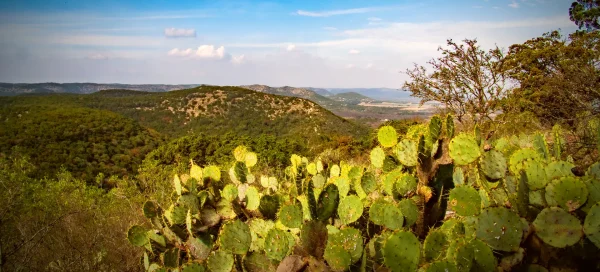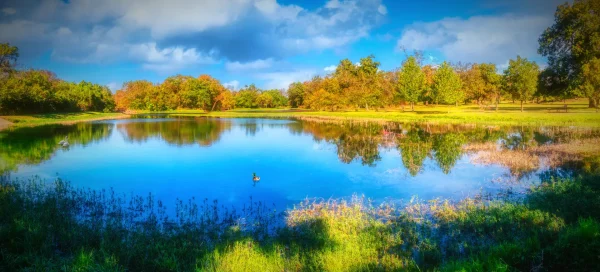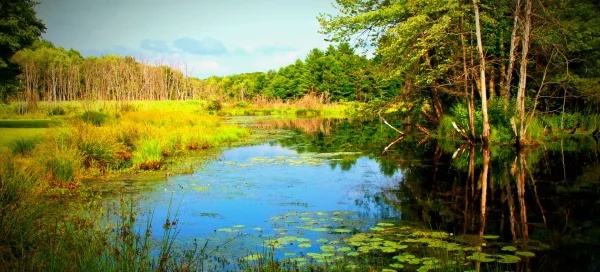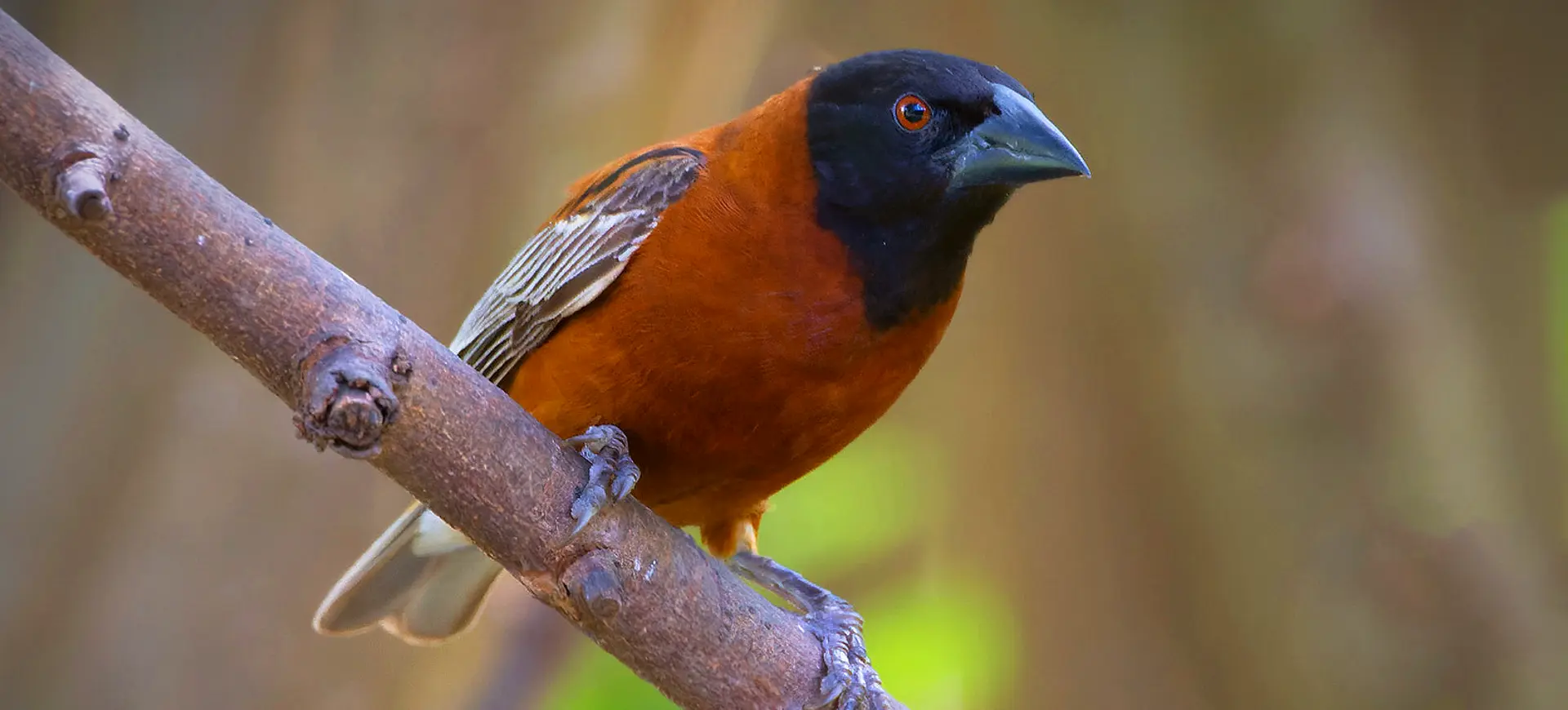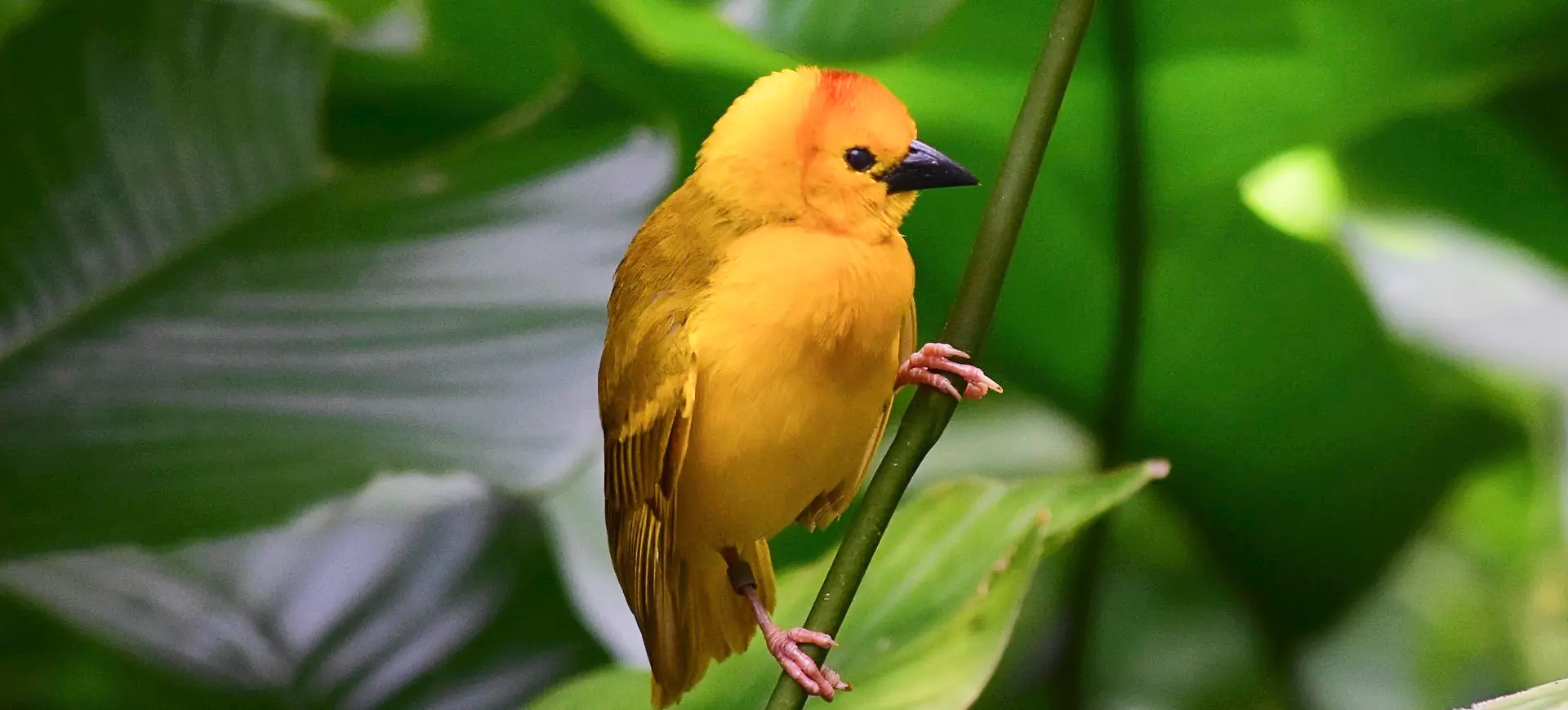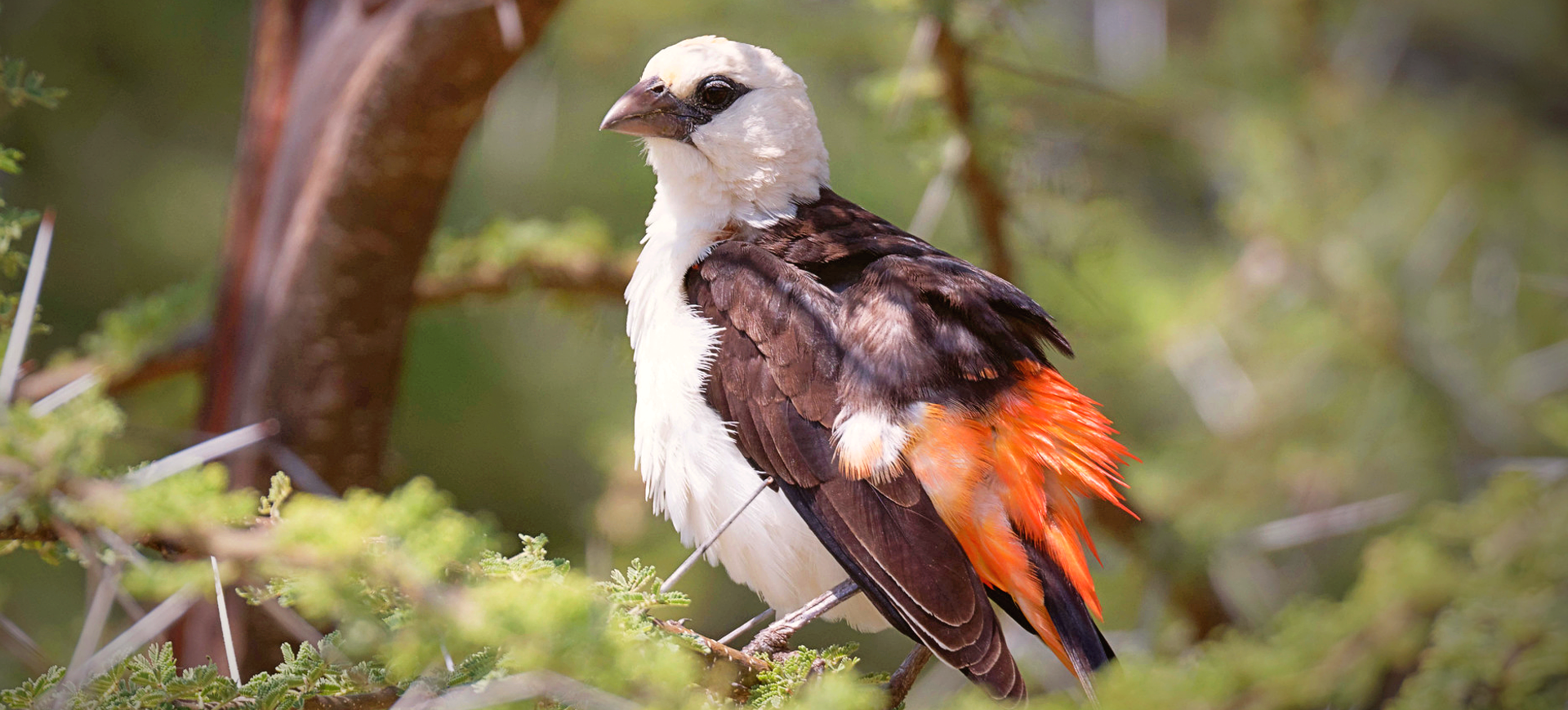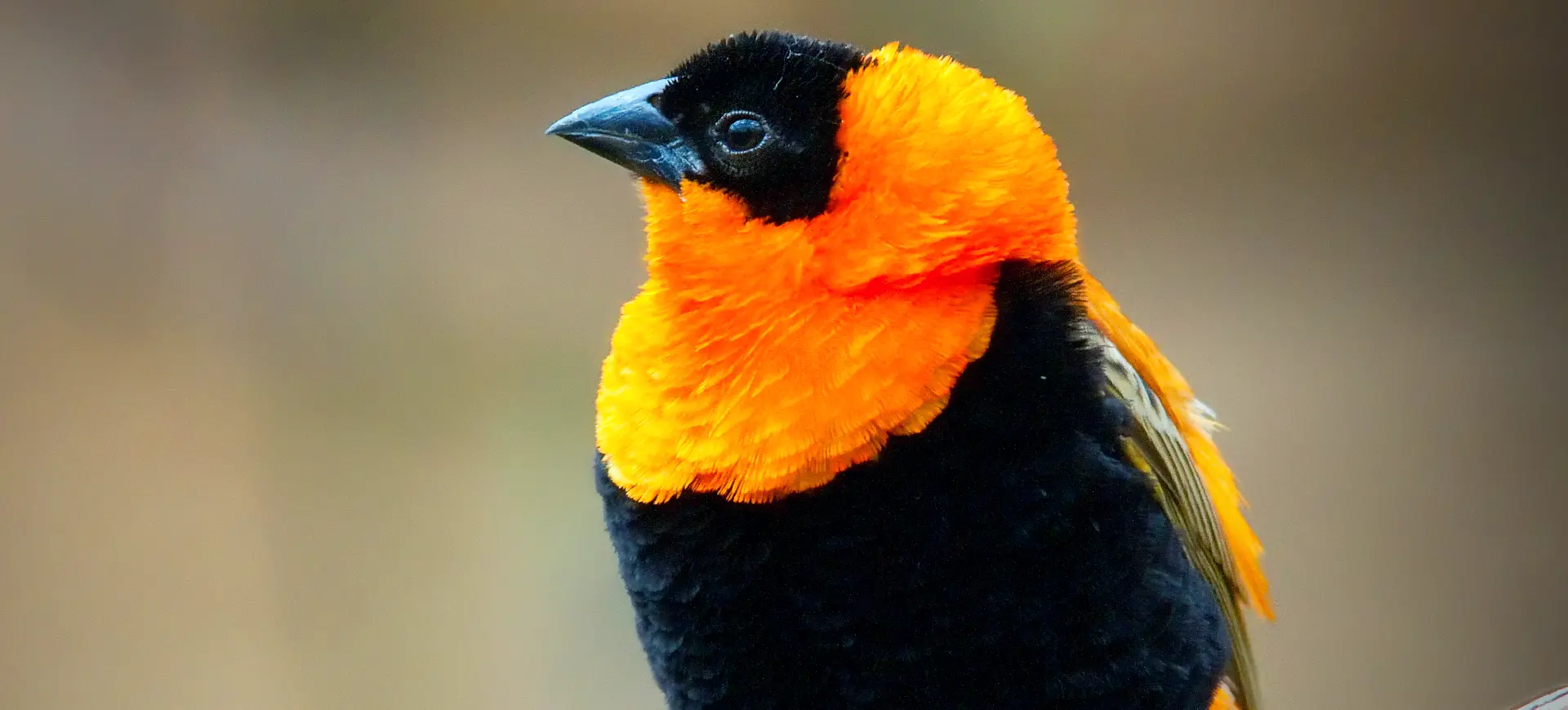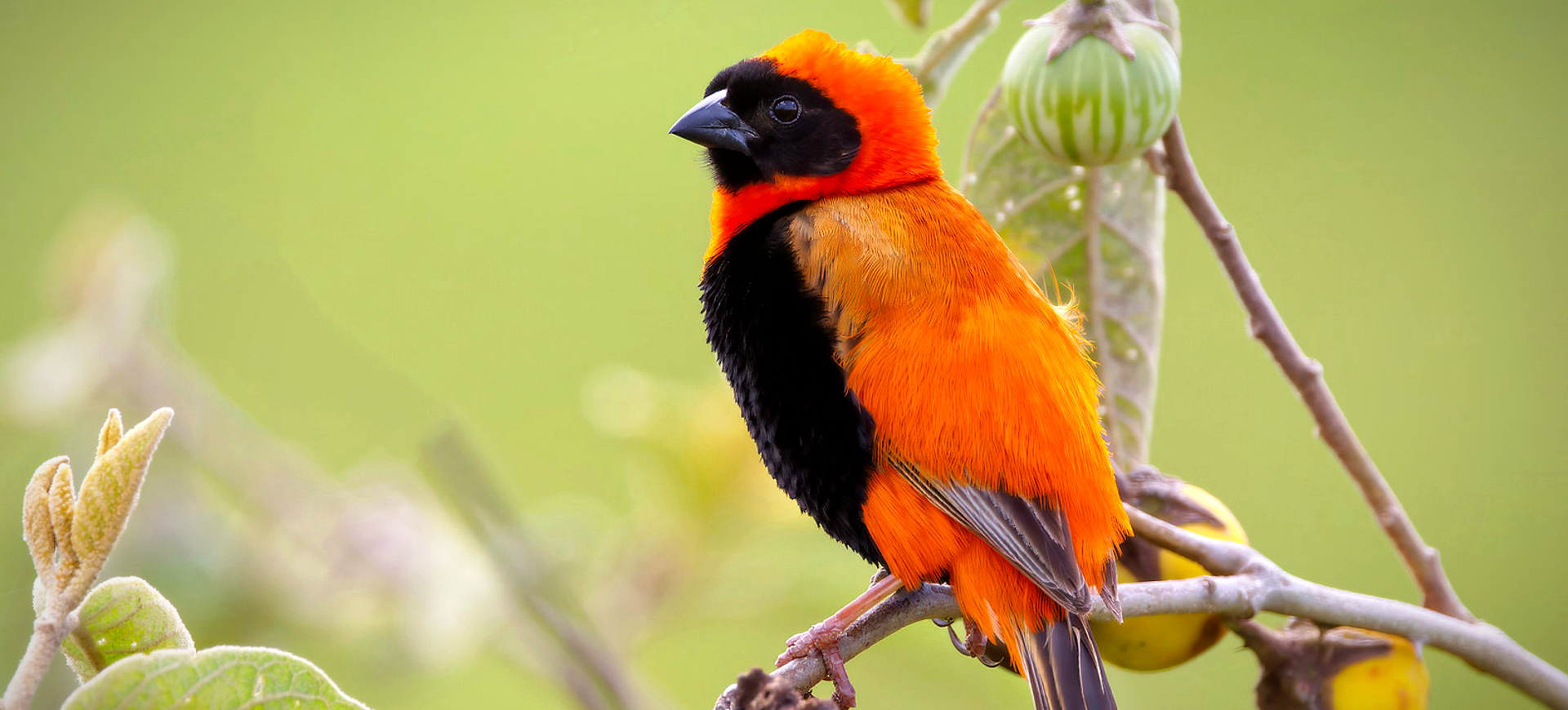Overview
The Yellow-crowned Bishop (Euplectes afer) is a strikingly colored passerine bird native to Africa, renowned for its vibrant plumage and dynamic breeding displays. Found across sub-Saharan Africa, this species thrives in grasslands, wetlands, and agricultural areas, often forming large flocks outside the breeding season. Males are particularly notable for their bright yellow and black breeding plumage, which they display prominently to attract females. During the non-breeding season, their coloration becomes more subdued, blending with the females and juveniles, maintaining a more consistent, cryptic brownish appearance year-round.
Yellow-crowned Bishops are highly social birds, engaging in complex mating dances and vocal displays to establish territories and attract mates. They are adaptable feeders, primarily consuming seeds supplemented by insects, which are especially important for the nutritional needs of their chicks during the breeding season. This species exhibits a remarkable ability to exploit a range of habitats, including those altered by human activity, allowing them to maintain stable populations in many areas despite habitat change and loss challenges.
The conservation status of the Yellow-crowned Bishop is currently assessed as of the least concern by the IUCN, reflecting its wide distribution and large, stable population numbers. However, like many species, it faces threats from extensive habitat destruction and degradation, particularly in wetland areas, which are crucial for their breeding success. Ongoing conservation efforts to preserve natural habitats and manage agricultural practices are vital to ensuring this vibrant bird species’ continued survival and prosperity.
Taxonomy
Kingdom
Phylum
Class
Order
Family
Genus
Species
Sub Species
Type
Physical Description:
In breeding plumage, male Yellow-crowned Bishops are a spectacle of nature’s artistry, with a bright yellow crown, back, and chest that starkly contrasts with their black belly, wings, and tail. This distinctive coloration serves as a visual signal in mating displays and establishes their presence and territory within the grasslands. Females and non-breeding males maintain a more muted appearance, with overall brown plumage and paler underparts, designed for camouflage against predators and when foraging on the ground. Both sexes exhibit a sparrow-like shape with a strong, conical beak adapted for their seed-based diet, embodying the typical weaver build that is robust and agile.
Adult Yellow-crowned Bishops typically measure about 4 to 4.7 inches in length, reflecting their small size within the weaver family. Despite the dramatic difference in coloration between genders during the breeding season, males and females share similar physical dimensions, making size a non-distinguishing factor. Their short, rounded wings support quick, darting flights over short distances, especially in dense, grassy habitats. The physical traits of the Yellow-crowned Bishop, including their vibrant breeding plumage and efficient feeding adaptations, showcase their specialized evolution for life in varied African landscapes.

Lifespan: Wild: ~5 years || Captivity: ~10 years

Weight: Male: 0.5-0.9 ounces (14-25 g) || Female: 0.5-0.9 ounces (14-25 g)

Length: Male: 4-4.7 inches (10-12 cm) || Female: 4-4.7 inches (10-12 cm)

Wingspan: Male & Female: 5-5.5 inches (12-14 cm)
Characteristic:
Native Habitat:
Yellow-crowned Bishops are native to sub-Saharan Africa, thriving in various grassland habitats, from dry savannas to moist floodplains. They strongly prefer areas with tall grasses, which provide food, nesting materials, and protection from predators. The species is particularly drawn to wetland edges and irrigated fields, where the combination of water and vegetation creates ideal conditions for breeding and foraging. Their habitat selection is influenced by the availability of suitable nesting sites and food sources, reflecting their needs throughout the year.
These birds have shown remarkable adaptability to human-modified landscapes, often found in agricultural areas where crops provide ample feeding opportunities. However, their dependence on specific habitats makes them sensitive to environmental changes, particularly those that result in habitat loss or degradation. The conservation of natural grasslands and wetlands is crucial for maintaining healthy populations of Yellow-crowned Bishops, ensuring that these vibrant ecosystems continue to support the diverse species that rely on them.
Biomes:
Biogeographical Realms:
Continents:
Countries:
Diet:
Diet & Feeding Habits:
The Yellow-crowned Bishop primarily feeds on seeds, demonstrating a preference for those from grasses, which constitute the bulk of their diet throughout the year. This granivorous diet is supplemented by occasional insects, particularly during the breeding season, when nutritional needs peak for adults and their offspring. Their strong, conical beaks are perfectly adapted for cracking open seeds, allowing them to efficiently access the nutrients inside. Feeding often occurs in flocks, where the safety in-numbers strategy helps protect them from predators while foraging on the ground.
Their feeding behavior benefits their survival and plays a role in seed dispersal across their habitats, contributing to the health and regeneration of grassland ecosystems. The adaptability of the Yellow-crowned Bishop to different types of grasslands, including those altered by agricultural activities, showcases their flexibility in foraging and nesting. This adaptability ensures their success in various environments, from natural grasslands to cultivated fields and wetland edges, where their preferred food sources are abundant.
Mating Behavior:
Mating Description:
The Yellow-crowned Bishop’s breeding season is characterized by a dramatic transformation in the males, who don vibrant yellow and black plumage to attract females. Males establish small territories within the grasslands, performing elaborate displays that include puffing up their feathers, singing, and engaging in aerial dances to showcase their fitness to potential mates. These displays attract females and establish dominance over other males, with the most vibrant and active individuals often securing the most mating opportunities. Females, attracted by the males’ displays, are responsible for building the nest and raising the young, often choosing sites in dense grasses near the ground for protection.
The breeding strategy of the Yellow-crowned Bishop, involving conspicuous visual signals and territorial displays, highlights the complex social interactions and behaviors that underpin reproductive success in this species. Following mating, females lay 2 to 4 eggs, which they incubate and rear independently, relying on the camouflage of their and the nest’s location to avoid predation. This reproductive cycle underscores the importance of specific habitat features, such as tall grasses and wetland edges, for successful breeding and offspring survival.
Reproduction Season:
Birth Type:
Pregnancy Duration:
Female Name:
Male Name:
Baby Name:
Social Structure Description:
Outside the breeding season, Yellow-crowned Bishops form large flocks that roam for food, demonstrating high sociality and cooperation among individuals. These flocks provide safety in numbers, reducing predation risk as they feed on the ground. During the breeding season, however, males become highly territorial, aggressively defending their chosen display areas from rivals to attract mates. This shift from gregarious to territorial behavior highlights the species’ complex social dynamics and the role of social interactions in their breeding strategy.
The cooperative nature of flocking behavior and the competitive interactions during the breeding season reflect the intricate balance between cooperation and competition in the Yellow-crowned Bishop’s life cycle. Understanding these social structures is crucial for appreciating the ecological roles and behaviors of this and other similar species, providing insights into the evolutionary pressures that shape their lives.
Groups:
Conservation Status:
Population Trend:
The Yellow-crowned Bishop is classified as Least Concern by the IUCN, which is indicative of its wide distribution and stable population sizes across much of sub-Saharan Africa. The species’ ability to thrive in various grassland habitats, including those altered by human activities, has contributed to its resilience and widespread presence. While the overall population is considered stable, local declines may occur due to habitat loss, degradation, and changes in wetland ecosystems, highlighting the need for ongoing monitoring and conservation efforts.
Efforts to conserve natural grasslands and wetlands are crucial for the Yellow-crowned Bishop, ensuring that these critical habitats continue to support the species and the broader biodiversity they harbor. Conservation initiatives that promote sustainable land use and protect against the drainage of wetlands can help mitigate the impacts of habitat loss, supporting the long-term stability of Yellow-crowned Bishop populations and preserving the ecological balance of their habitats.
Population Threats:
The main threats to the Yellow-crowned Bishop include habitat loss and degradation, primarily driven by agricultural expansion, urbanization, and the draining of wetlands. These activities can lead to the loss of vital breeding and feeding habitats, impacting the species’ ability to find suitable nesting sites and food sources. Additionally, the use of pesticides in agriculture can reduce the availability of seeds and potentially harm non-target species, including the Yellow-crowned Bishop. Climate change also poses a long-term threat, with shifts in rainfall patterns potentially affecting the availability of wetland habitats crucial for breeding.
Despite these challenges, the Yellow-crowned Bishop’s adaptability to different environments has enabled it to maintain stable populations in many areas. Conservation efforts focused on habitat preservation, sustainable agricultural practices, and the protection of wetlands are essential for mitigating these threats and ensuring the continued success of the Yellow-crowned Bishop across its range.
Conservation Efforts:
Conservation efforts for the Yellow-crowned Bishop are largely focused on habitat preservation and protecting critical grassland and wetland ecosystems. Initiatives that protect natural habitats from conversion to agriculture or urban development are vital for maintaining the ecological balance necessary for the species’ survival. Sustainable land management practices incorporating wildlife needs can help ensure agricultural landscapes remain hospitable to Yellow-crowned Bishops and other grassland species.
Education and awareness programs highlighting the importance of biodiversity and ecosystem health can foster greater appreciation and support for conservation efforts. By working with local communities, conservationists can promote practices that benefit people and wildlife, ensuring that the vibrant Yellow-crowned Bishop thrives in Africa’s grasslands for generations.
Additional Resources:
Fun Facts
- The Yellow-crowned Bishop is named for its striking yellow crown, which males prominently display during the breeding season.
- It is capable of dramatic transformations, with males changing from a muted brown to a vibrant yellow and black to attract mates.
- These birds are known for their elaborate mating dances, where males puff up, leap into the air, and sing to woo females.
- Females are solely responsible for nest building and raising the young, often choosing concealed sites to protect against predators.
- The species has adapted well to human-altered landscapes, often thriving in agricultural areas with abundant food sources.
- Yellow-crowned Bishops play a role in seed dispersal, contributing to the health of their grassland habitats.
- They are highly social outside the breeding season, forming large flocks that offer protection and increased foraging efficiency.
- The bird’s vibrant breeding plumage and dynamic displays make it a favorite among birdwatchers and photographers.
- Conservation efforts focused on habitat preservation are key to ensuring the long-term survival of the Yellow-crowned Bishop.
- Despite their small size, Yellow-crowned Bishops have a strong presence in their habitats, highlighting the importance of even the smallest species in maintaining ecological balance.

